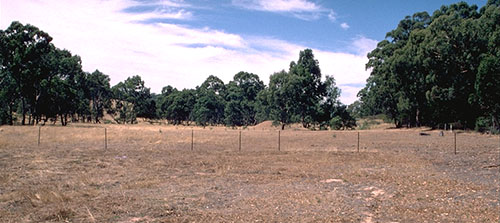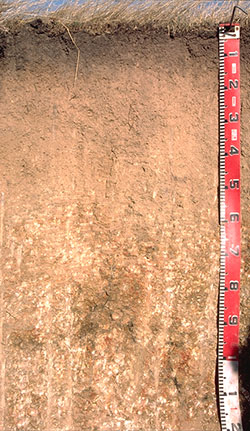LP104
Australian Soil Classification: Bleached-mottled, Subplastic, Brown CHROMOSOL
Northocte Factual Key: Dy 3.43
Great Soil Group: Soloth
Site Description: Alluvial terrace. Original vegetation includes Yellow box (Eucalyptus melliodora) and Red Stringybark (E. macrorhyncha).
Geology: Sandstone/Siltstone

Soil Profile Morphology
Surface Soil
| A1 | 0-7 cm | Dark yellowish brown (10YR3/4) fine sand; massive structure; weak consistence dry; pH 5.7; clear change to: |  LP103 Profile |
| A21 | 7-50 cm | Light yellowish brown (10YR6/4), conspicuously bleached very pale brown (10YR8/3d); fine sand; massive; weak consistence dry; pH 5.9; clear change to: | |
| A22 | 50-55 cm | Yellow (10YR7/6), conspicuously bleached white (10YR8/2d); fine sandy clay loam; massive; strong consistence dry; pH 5.5; abrupt change to: | |
| Subsoil | |||
| B21 | 55-70 cm | Yellowish brown (10YR5/4), with strong brown (7.5YR5/8) mottle; medium clay; subplastic; weak medium blocky structure breaking down to moderate fine polyhedral structure; strong consistence dry; pH 6.0; clear change to: | |
| B22 | 70-85 cm | Yellowish red (5YR5/6), with strong brown (7.5Y5/8) and yellowish brown (10YR5/4) mottles; light medium clay; moderate fine blocky structure; strong consistence dry; pH 6.6; clear change to: | |
| B23 | 85-110 cm | Yellowish red (5YR5/6), with many brownish yellow (10YR6/6) mottles; light medium clay; weak medium blocky structure; strong consistence dry; pH 6.6. | |
Key Profile Features
- Strong texture contrast between surface (A) and the top subsoil (B21) horizon.
- Conspicuously bleached subsurface (A2) horizon
Key Profile Characteristics
pH | Salinity Rating | ||
Surface (A1 horizon) | Moderately Acid | Very Low | Non-Sodic |
Subsoil (B21 horizon) | Moderately Acid | Very Low | Non-Sodic |
Deeper subsoil (70 cm) | Slightly Acid | Very Low | Non-Sodic |

| The A horizon is moderately acid. The B horizon is slightly acid. | The salinity rating is very low.
| This profile is non-sodic. | Low clay content in the surface, with a sharp increase at the A/B interface. |
Horizon | Horizon Depth (cm) | pH (water) | pH (CaCl2) | EC dS/m | Exch. Al ppm | Organic Carbon % | Exchangeable Cations | Coarse Sand (0.2-2.0 mm) % | Fine Sand (0.02-0.2 mm) % | Silt (0.002-0.02 mm) % | Clay (<0.002 mm) % | Wilting Point % w/w | |||
Ca | Mg | K | Na | ||||||||||||
meq/100g | |||||||||||||||
A1 | 0-7 | 5.7 | 4.4 | <0.05 | 1.2 | 1.1 | 0.38 | 0.54 | 0.06 | 2.8 | |||||
A2 | 7-50 | 5.9 | 4.6 | <0.05 | 0.32 | 0.22 | 0.18 | 0.05 | 1 | 84 | 10 | 3 | 1.1 | ||
A3 | 50-55 | 5.5 | 4.7 | 0.06 | 10 | 1.2 | 1.6 | 0.35 | 0.18 | 1 | 67 | 14 | 21 | 5.1 | |
B21 | 55-70 | 6.0 | 5.3 | 0.11 | 3.7 | 4.8 | 1.0 | 0.44 | 2 | 38 | 8 | 57 | 15.7 | ||
B22 | 70-85 | 6.6 | 5.8 | 0.10 | 4.1 | 4.9 | 0.94 | 0.49 | |||||||
B23 | 85-110 | 6.6 | 5.8 | 0.06 | 2.7 | 3.6 | 0.52 | 0.32 | |||||||
Management Considerations:
Profile Described By: Mark Imhof, Paul Rampant and Karen DePlater, November 1995 |


